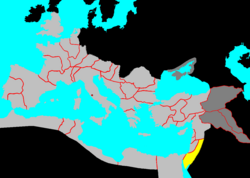106
| الألفية: | الألفية 1 |
|---|---|
| القرون: | القرن 1 - القرن 2 - القرن 3 |
| العقود: | عقد 70 عقد 80 عقد 90 - عقد 100 - عقد 110 عقد 120 عقد 130 |
| السنوات: | 103 104 105 - 106 - 107 108 109 |
| 106 حسب الموضوع | |
| السياسة | |
| زعماء الدول – الدول ذات السيادة | |
| تصنيفات المواليد والوفيات | |
| المواليد – الوفيات | |
| تصنيفات التأسيسات والانحلالات | |
| تأسيسات – انحلالات | |
| التقويم الگريگوري | 106 CVI |
| آب أوربه كونديتا | 859 |
| التقويم الأرمني | N/A |
| التقويم الآشوري | 4856 |
| التقويم البهائي | −1738 – −1737 |
| التقويم البنغالي | −487 |
| التقويم الأمازيغي | 1056 |
| سنة العهد الإنگليزي | N/A |
| التقويم البوذي | 650 |
| التقويم البورمي | −532 |
| التقويم البيزنطي | 5614–5615 |
| التقويم الصيني | 乙巳年 (الخشب الثعبان) 2802 أو 2742 — إلى — 丙午年 (النار الحصان) 2803 أو 2743 |
| التقويم القبطي | −178 – −177 |
| التقويم الديسكوردي | 1272 |
| التقويم الإثيوپي | 98–99 |
| التقويم العبري | 3866–3867 |
| التقاويم الهندوسية | |
| - ڤيكرام سامڤات | 162–163 |
| - شاكا سامڤات | 28–29 |
| - كالي يوگا | 3207–3208 |
| تقويم الهولوسين | 10106 |
| تقويم الإگبو | −894 – −893 |
| التقويم الإيراني | 516 ق.ر. – 515 ق.ر. |
| التقويم الهجري | 532 ق.هـ. – 531 ق.هـ. |
| التقويم الياباني | N/A |
| تقويم جوچى | N/A |
| التقويم اليوليوسي | 106 CVI |
| التقويم الكوري | 2439 |
| تقويم مينگوو | 1806 قبل جمهورية الصين 民前1806年 |
| التقويم الشمسي التايلندي | 649 |
Year 106 (CVI) was a common year starting on Thursday (link will display the full calendar) of the Julian calendar. At the time, it was known as the Year of the Consulship of Commodus and Civica (or, less frequently, year 859 Ab urbe condita). The denomination 106 for this year has been used since the early medieval period, when the Anno Domini calendar era became the prevalent method in Europe for naming years.
أحداث
حسب المكان
الامبراطورية الرومانية
- Ignatius writes a letter to Christians in Smyrna, using the term Catholic Church (تاريخ تقريبي). This is the earliest surviving witness to the use of the term "Catholic Church".
- Emperor Trajan conquers the Dacian Fortresses of the Orăştie Mountains, and surrounds the capital, Sarmizegetusa.
- Battle of Sarmizegetusa: The Dacians are defeated, and the city is encircled with a circumvallation line. When the Romans destroy the water pipes, King Decebalus flees, and commits suicide.
- August 11 – The south-eastern part of Dacia (modern Romania) becomes a Roman province: Roman Dacia. The veterans of the legions are given land in the new province for their service in the Roman army.
- تراجان يضم مملكة الأنباط (وعاصمتها پترا) كمقاطعة رومانية أرابيا پترايا. The epoch of the calendar of the province of Arabia begins on 22 مارس.
الصين
- 13 فبراير - الإمبراطور He of Han dies after a 18-year reign. Empress Dowager Deng places her infant son Han Shangdi on the Chinese throne. First and the only year of yanping era.
- 21 سبتمبر - Han Shangdi dies after a 7-month reign and is succeeded by his 12-year-old cousin Han Andi كحاكم على أسرة هان الشرقية الصينية (حتى 125).
حسب الموضوع
الأدب
- Aelianus Tacticus (or Aelian) writes his Taktike Theoria (تاريخ تقريبي).
وفيات
- 13 فبراير – He of Han, Chinese emperor of the أسرة هان (و. AD 79)[1]
- 21 سبتمبر - Han Shangdi, Chinese emperor of the Han Dynasty (و. 105)[2]
- Decebalus, king of Dacia (suicide, being pursued by the Romans) (و. AD 87)[3]
- ليو چينگ, Chinese prince of the Han Dynasty (و. AD 78)[4]
- رب إيل الثاني، حاكم مملكة الأنباط.
المراجع
- ^ Rafe de Crespigny (28 December 2006). A Biographical Dictionary of Later Han to the Three Kingdoms (23-220 AD). BRILL. pp. 531–. ISBN 978-90-474-1184-0.
- ^ Tan Koon San (15 August 2014). Dynastic China: An Elementary History. The Other Press. pp. 111–. ISBN 978-983-9541-88-5.
- ^ A Companion to Latin Studies. CUP Archive. pp. 140–. GGKEY:2AE1DU53Z2Y.
- ^ Michael Loewe (2 June 2016). Problems of Han Administration: Ancestral Rites, Weights and Measures, and the Means of Protest. BRILL. pp. 72–. ISBN 978-90-04-31490-0.

